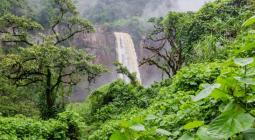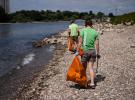The proposed 800-kilometre pipeline route now overlaps with the planned IPCA. Gitanyow chiefs argue it poses significant risks to their salmon-dependent culture and livelihood, and that its outdated environmental certificate no longer makes sense in an accelerating climate crisis.
“This is a bit of a defensive move,” Wilp (house group) Sustainability Director Tara Marsden, whose Gitksan name is Naxginkw, told The Energy Mix. “The IPCA will be protected first in our law, and then we will seek to have the provincial government recognize that in whatever form they choose.”
The IPCA, called Ganeda, stems from Gitanyow ayookx or ancestral law, upheld by the Nation’s governance system comprising eight hereditary chiefs who make collective decisions. B.C. affirmed Gitanyow’s self-governance most recently through a funding agreement in 2024, but the province hasn’t followed through with legal recognition of IPCAs, though they are a growing movement to return land stewardship to First Nations.
“The declaration of an IPCA does not change the province’s existing legal requirements or the province’s legal framework for the land within that area,” writes [pdf] the provincial government in an explanatory pamphlet. “The expression of First Nation’s stewardship intentions provides important information to assist in building a positive relationship with the Nation and inform future engagement with the Nation.”
Experts say IPCAs are a “legal grey zone.” There remains a big question about how the province will recognize these Indigenous protected areas, especially if they stand in the way of resource development.
For an IPCA’s potential and promise to be fulfilled, the province must “get onside and support First Nation’s rights to care for and govern their territories, which Nations have successfully done for countless generations prior to contact,” Estella White, a staff lawyer at West Coast Environmental Law who carries the name ḥin̓ačačišt from the Hesquiaht First Nation, told The Mix in an email.
IPCAs on The Rise
IPCAs are a hot topic in conservation in Canada. First Nations experts define [pdf] them as “lands and waters where Indigenous governments have the primary role in protecting and conserving ecosystems through Indigenous laws, governance, and knowledge systems.”
“They are rooted in ancestral and historic rights and stewardship responsibilities for our territories,” said Marsden. “But the Indigenous Protected and Conserved Areas are a movement.”
Canadian conservation initiatives have traditionally excluded Indigenous groups from conservation areas under the ideal of preserving nature from human interference. IPCAs instead centre Indigenous coexistence with their traditional territories, including harvesting, hunting, and management practices, writes Michelle Cyca for The Narwhal.
Many IPCAs operate through hired Guardians who monitor ecological health and ensure that only permitted Indigenous harvesting occurs on the territories. On the Gitanyow Lax’yip, or territory, guardians monitor streamflow, salmon counts, water temperature, and other metrics that tell the story of their changing ecosystems.
Canada’s biodiversity strategy prioritizes Indigenous leadership in conservation, with the announcement in June 2024 of up to C$6 million in funding for 49 Indigenous conservation projects across Canada, one of them a bumblebee protection initiative on a Métis-led IPCA.
In 2021, the federal government committed C$340 million over five years to support a national Indigenous guardians network and fund Indigenous Protected Areas. “It is heartening to see the recognition of the role of Indigenous conservation and stewardship in achieving Canada’s ambitions in terms of its biodiversity goals and certainly in terms of keeping carbon where it is, which is in the ground,” Indigenous Leadership Initiative Director Valérie Courtois told The Narwhal at the time.
So far, the province has been silent about the Ganeda IPCA, Marsed said. But that isn’t stopping Gitanyow from getting Guardians on the ground. It does, however, raise questions about whether the IPCA’s protected status will protect it from the pipeline.
“First Nations are on the ground doing the work to declare IPCAs, develop management plans, and stand up their laws to govern and care for their territories, while the Crown continues to assert authority over those territories and make decisions contrary to those set out in an IPCA,” said White.
This isn’t the first time Gitanyow has created an IPCA without involvement from the province. Gitanyow declared the Meziadin watershed—a crucial fish habitat in their territory—as an IPCA in 2021. Although Gitanyow has been working with the province to restore hereditary systems of governance and to protect the watershed, the Narwhal reported the province still hasn’t acknowledged that IPCA two years later.
There is also the legal precedent of B.C.’s 2019 ratification of the UN Declaration of the Rights of Indigenous Peoples. “By failing to recognize IPCAs and the Indigenous laws, languages, and governance that uphold them, the Crown is failing to recognize and uphold their own laws,” said White.
When governments face expressions of Indigenous laws, they have to do something, said Marsden. “They can’t just ignore them,”
Protesting The Pipeline in Provincial Courts
Gitanyow has also engaged with provincial courts. The community filed a lawsuit against the BC Energy Regulator—a Crown corporation that regulates energy projects—over violations in the PRGT environmental impact assessment process. The chiefs also applied for judicial review to halt development of the Ksi Lisims terminal, citing failure to consult.
The 2014 PRGT environmental impact assessment approved the Ksi Lisims floating LNG terminal at the mouth of the Nass river without consulting the Gitanyow, since the terminal is not within their territory. But the chiefs say the terminal’s potential impact on juvenile salmon risks their traditional food, culture, and livelihood. Endangered wild Chinook salmon spawn at the Sacred Headwaters in Tahltan territory, then swim down the Nass River through Gitanyow traditional waters to the ocean—where Marsden described them as “vulnerable because they’re transitioning to the saltwater habitat.”
Juvenile salmon have been found near the terminal site, but Marsden said the province refused to do DNA testing to determine where they come from, which would show which salmon, and thus which Nation, the terminal could affect.
The province is sticking with its plans to push LNG development. On January 17, Premier David Eby amended legislation to push through another pipeline—the North Coast Transmission Line—without environmental review from the BC Energy Regulator. The LNG industry extensively lobbied the BC Energy Regulator, reports The Tyee.
Gitanyow Criticizes Outdated PRGT Environmental Assessment
When it comes to the 2014 PRGT environmental assessment, the Gitanyow hereditary chiefs argue it is outdated, as it was approved five years before B.C. enshrined Indigenous rights into law. Additionally, the pipeline’s permit was issued under significantly different environmental circumstances. Its route has changed, and climate change has exacerbated risks to salmon and forests, said Marsden.
The project began construction in August 2024, all on Nisga’a territory, nearly 10 years after the assessment was issued, and only three months before it was set to expire.
Environmental Assessments expire after 10 years, unless the permit holder can prove that the project has “substantially started.”
The PRGT filed an application for substantial start designation on November 25 to extend their permit. Environmental Assessment Office (EAO field officers evaluated work and construction on November 26 and 27 to determine how far construction has gone, the EAO told The Mix in an email.
“This information-gathering is to support the determination of whether the project has been substantially started, a process that will take some time.”
In spring 2025, the EAO is expected to deliver its report to B.C.’s new Minister of the Environment, Tamara Davidson, the NDP MLA and Haida Nation member representing North Coast-Haida Gwaii. Davidson will choose to extend or deny the permit, and by extension, whether to recognize and respect the Ganeda IPCA.
With or without state recognition, Marsden said the community is planning to hire Guardians for the IPCA to watch the land in the path of the PRGT pipeline.
“At the end of the day, this is our land, it’s under threat, and we have to do what’s right for future generations,” said Marsden.






